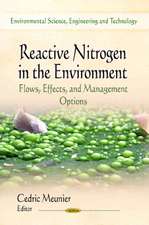Cyanobacteria for Bioremediation of Wastewaters
Editat de Inga Zinicovscaia, Liliana Cepoien Limba Engleză Hardback – 17 ian 2016
| Toate formatele și edițiile | Preț | Express |
|---|---|---|
| Paperback (1) | 632.55 lei 6-8 săpt. | |
| Springer International Publishing – 30 mar 2018 | 632.55 lei 6-8 săpt. | |
| Hardback (1) | 638.76 lei 6-8 săpt. | |
| Springer International Publishing – 17 ian 2016 | 638.76 lei 6-8 săpt. |
Preț: 638.76 lei
Preț vechi: 751.47 lei
-15% Nou
Puncte Express: 958
Preț estimativ în valută:
122.24€ • 127.15$ • 100.92£
122.24€ • 127.15$ • 100.92£
Carte tipărită la comandă
Livrare economică 14-28 aprilie
Preluare comenzi: 021 569.72.76
Specificații
ISBN-13: 9783319267494
ISBN-10: 3319267493
Pagini: 124
Ilustrații: IX, 124 p. 42 illus.
Dimensiuni: 155 x 235 x 10 mm
Greutate: 0.37 kg
Ediția:1st ed. 2016
Editura: Springer International Publishing
Colecția Springer
Locul publicării:Cham, Switzerland
ISBN-10: 3319267493
Pagini: 124
Ilustrații: IX, 124 p. 42 illus.
Dimensiuni: 155 x 235 x 10 mm
Greutate: 0.37 kg
Ediția:1st ed. 2016
Editura: Springer International Publishing
Colecția Springer
Locul publicării:Cham, Switzerland
Public țintă
ResearchCuprins
1. Introduction.- 2. Water quality: A major global problem.- 3. Conventional methods of wastewater treatment.- 4. Removal of organic pollutants from wastewater by cyanobacteria.- 5. Biological methods of wastewater treatment.- 6. Metals removal by cyanobacteria and accumulation in biomass.- 7. Nanoparticle biosynthesis based on the protective mechanism of cyanobacteria.
Recenzii
“The book ‘Cyanobacteria for Bioremediation of Wastewaters’ deals with a very interesting and modern topic: the importance of cyanobacteria, oxygenic photosynthetic prokaryotes, for the bioremediation of wastewater, with special emphasis on removal of organic pollutants and metals from wastewater. … a valuable reading for undergraduated students as well as for already known scientists working in the field of bio(nano) technology, and managers.” (Prof. Ioan I. Ardelean, Bulletin of Micro and Nanoelectrotechnologies, Vol. 7 (3-4), 2015)
Notă biografică
Dr. Liliana CEPOI, specialist in Phycobiotechnology, is deputy director of the Institute of Microbiology and Biotechnology of the Academy of Sciences of Moldova. She has extensive teaching experience as associate professor at the University of the Academy of Sciences, giving following bachelor, master and doctoral level courses: Microbiology, Systematics and Phylogeny, Molecular Phylogeny, Methodology of Knowledge in Biology.
Her research interests include: controlled synthesis of bioactive compounds; study of oxidative stress evolution mechanisms in cyanobacteria and microalgae; application of cyanobacteria in environmental bioremediation.
Dr. L.Cepoi has co-authored 30 patents in the field of phycobiotechnology. She has received the WIPO Gold Medal Award “Best Woman Inventor”.
Dr. Inga ZINICOVSCAIA, specialist in bionanotechnology, is researcher in the Frank Laboratory of Neutron Physics of the Joint Institute for Nuclear Research and Institute of Chemistry of the Academy of Sciences of Moldova.
Her research interests include: application of neutron activation analysis in biotechnology and environmental studies; synthesis of metal nanoparticles using cyanobacteria and bacteria; application of cyanobacteria and bacteria in wastewater treatment. Dr. I. Zinicovscaia is co-author of 30 publications in international journals and the winner of various scholarships and grants.
Scientific area of interests of both authors overlap in biosorption and bioaccumulation of chemical elements by phycological objects. Thematic approach from two points of view-chemical and biological- is a condition for success in their joint research. For work on wastewater bioremediation both authors have been awarded with two Gold Medals on the European Exhibition of Creativity and Innovation.
Her research interests include: controlled synthesis of bioactive compounds; study of oxidative stress evolution mechanisms in cyanobacteria and microalgae; application of cyanobacteria in environmental bioremediation.
Dr. L.Cepoi has co-authored 30 patents in the field of phycobiotechnology. She has received the WIPO Gold Medal Award “Best Woman Inventor”.
Dr. Inga ZINICOVSCAIA, specialist in bionanotechnology, is researcher in the Frank Laboratory of Neutron Physics of the Joint Institute for Nuclear Research and Institute of Chemistry of the Academy of Sciences of Moldova.
Her research interests include: application of neutron activation analysis in biotechnology and environmental studies; synthesis of metal nanoparticles using cyanobacteria and bacteria; application of cyanobacteria and bacteria in wastewater treatment. Dr. I. Zinicovscaia is co-author of 30 publications in international journals and the winner of various scholarships and grants.
Scientific area of interests of both authors overlap in biosorption and bioaccumulation of chemical elements by phycological objects. Thematic approach from two points of view-chemical and biological- is a condition for success in their joint research. For work on wastewater bioremediation both authors have been awarded with two Gold Medals on the European Exhibition of Creativity and Innovation.
Textul de pe ultima copertă
This book reflects the use of cyanobacteria for the bioremediation of wastewater through different mechanisms and pathways of transformation and transfer of hazardous substances from one medium to another. The application of microorganisms for bioremediation is determined by their ubiquity, small size, high rate of reproduction and large surface-to-volume cell ratio. Mechanisms of interaction of cyanobacteria with inorganic pollutants include biosorption, bioaccumulation with an opportunity to obtain metal nanoparticles both on the cell surface and inside the cells as well as chelation and inclusion of metals in the composition of certain organic structures. Data presented in the book provides specialists in the field with useful information for bioremediation technologies as well as for obtaining valuable preparations using cyanobacteria.
Caracteristici
Fast, cheap, environmentally friendly method
Flexibility, specific adaptations and resistance of cyanobacteria
Variety of mechanisms of environment depollution
Avoidance of use of toxic chemicals
Flexibility, specific adaptations and resistance of cyanobacteria
Variety of mechanisms of environment depollution
Avoidance of use of toxic chemicals













